Micron has released a new version of their RealSSD C400 SSD in an mSATA form factor. While most consumers aren’t familiar with the C400 line, it closely mirrors the performance and design of the client-facing Crucial m4. The C400 mSATA SSD will be offered through Micron’s OEM partners and will generally be found in the ultrathin compute space where mSATA SSDs are finding great strength in caching and in some cases even as primary storage. The C400 mSATA SSD leverages a SATA 6Gb/s interface, 25nm Micron NAND and a Marvell 9174 controller.
The SSDs ship in 32GB, 64GB, 128GB and 256GB capacities. The 32GB and 64GB carry the C400v branding and are more geared for read caching duty, while the 128GB and 256GB C400 drives are more performance oriented and designed for primary storage duties. No matter the capacity, the C400 mSATA drives offer the performance benefits of SSDs while keeping a weight profile of under 10 grams and power consumption to a minimum, which are both critical to the ultrathin computing space.
The C400 mSATA SSDs will be warrantied by the OEM and may vary based on deployment. Micron plans to release a consumer available version of the drive at some point under the Crucial brand name.
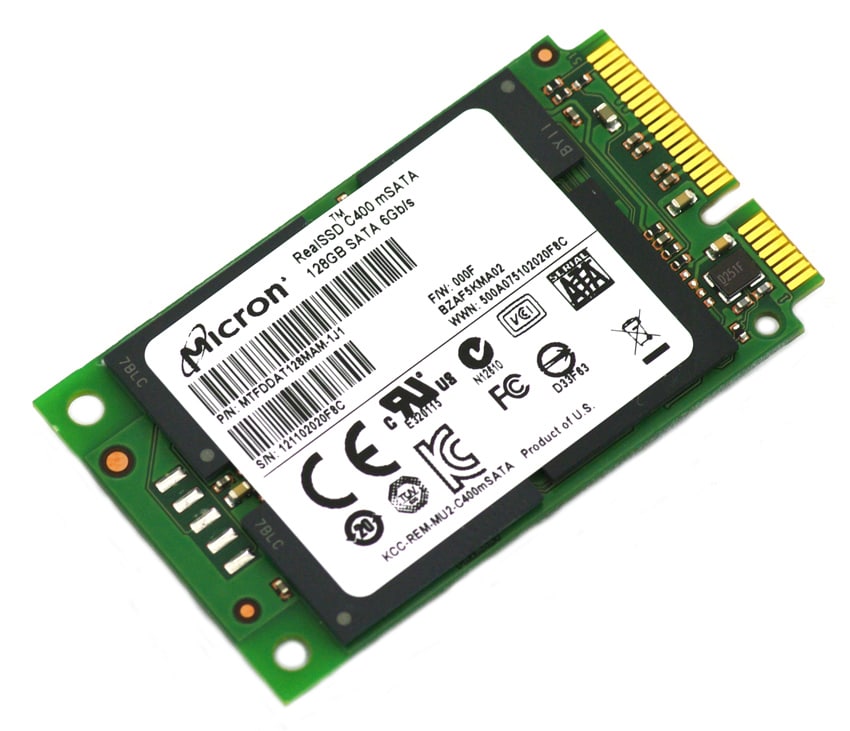
Micron RealSSD C400 mSATA SSD Specs
- Capacities
- C400v mSATA
- 32GB – MTFDDAT032MAM-1J1
- Sequential Read – up to 440 MB/s
- Sequential Write – up to 50 MB/s
- 64GB – MTFDDAT064MAM-1J1
- Sequential Read – up to 500 MB/s
- Sequential Write – up to 95 MB/s
- 32GB – MTFDDAT032MAM-1J1
- C400 mSATA
- 128GB – MTFDDAT128MAM-1J1
- Sequential Read – up to 500 MB/s
- Sequential Write – up to 175 MB/s
- 256GB – MTFDDAT256MAM-1K1
- Sequential Read – up to 500 MB/s
- Sequential Write – up to 260 MB/s
- 128GB – MTFDDAT128MAM-1J1
- Interface SATA 6 Gb/s
- Micron 25nm MLC NAND
- Marvell 9174 Controller
- Active Average Power Consumption – C400v <150mW, C400 <200mW
- Idle Power Consumption – C400V <65mW, C400 <85mW
- Operating Temp Commercial (0˚C to +70˚C)
- Dimensions – 29.9 x 50.8 x 3.75 mm
- Weight – 10g max
- C400v mSATA
Build and Design
The Micron RealSSD C400 mSATA follows the standard mSATA form-factor, with a SATA 6Gb/s interface. With all the components exposed by design (minus one sticker removed for photos) there is no disassembly to see all the parts that make this drive complete. The board includes the condensed parts of a 2.5-inch Micron C400 SSD, in a fraction of the footprint. The top includes the controller, SDRAM, and two pieces of 25nm MLC NAND.
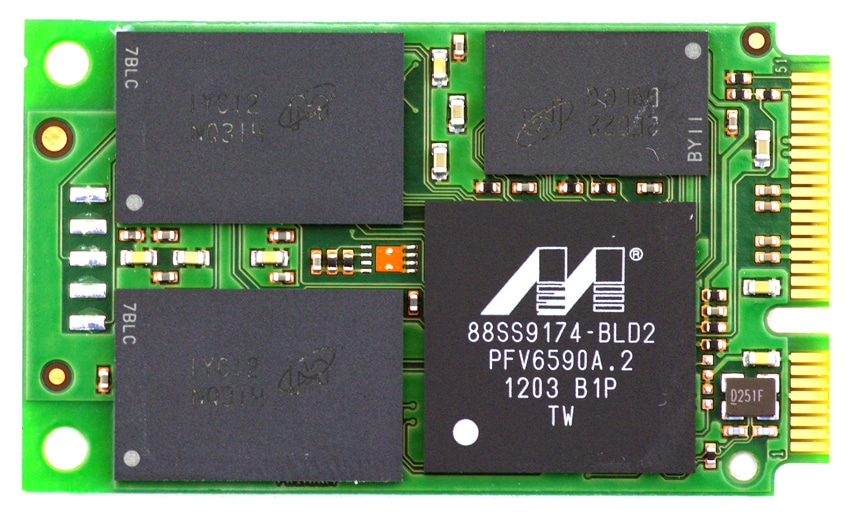
The bottom of the RealSSD C400 mSATA includes two additional pieces of NAND, giving the device a total of four 32GB pieces.
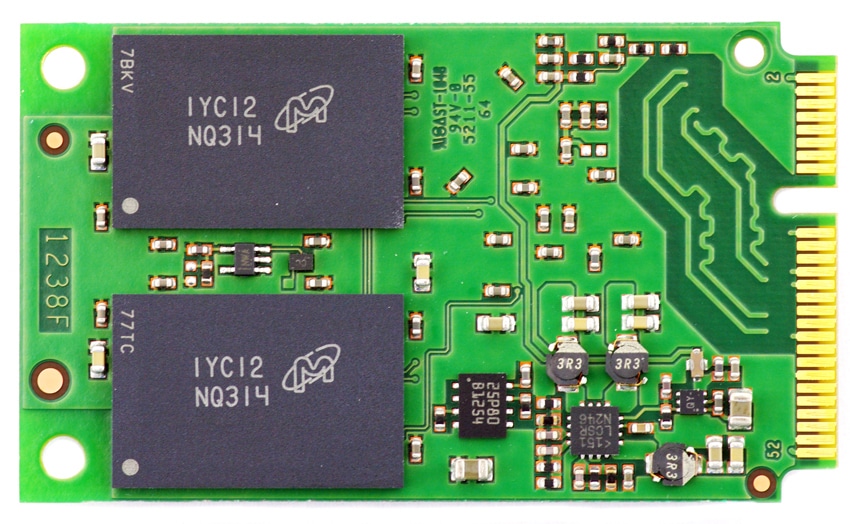
As a storage solution sold directly to computer manufacturers, the RealSSD C400 mSATA is sold by itself, unlike other mSATA devices that may include interposer cards.
Synthetic Benchmarks
The Micron C400 mSATA SSD uses Micron’s own 25nm synchronous MLC NAND, a Marvell 9174 controller and 6.0Gb/s SATA interface; our review unit is 128GB. The comparables used for this review include the following recently tested SSDs: Intel SSD 310 (80GB, Intel PC29AS21BA0, Intel 25nm NAND, 3Gb/s SATA), Renice X3 (120GB, SandForce SF-1222, Micron MLC NAND, 3Gb/s SATA), and the OCZ Nocti (120GB, SandForce SF-2181, OCZ 2xnm MLC NAND, 3Gb/s mSATA). All IOMeter figures are represented as binary figures for MB/s speeds. All mSATA SSDs were tested on our client testing platform over an Intel SATA 6.0Gb/s through an interposer card.
Our first test measures peak straight-line performance through a large-block sequential transfer. Micron lists a peak read speed of 500MB/s and a write speed of 175MB/s.
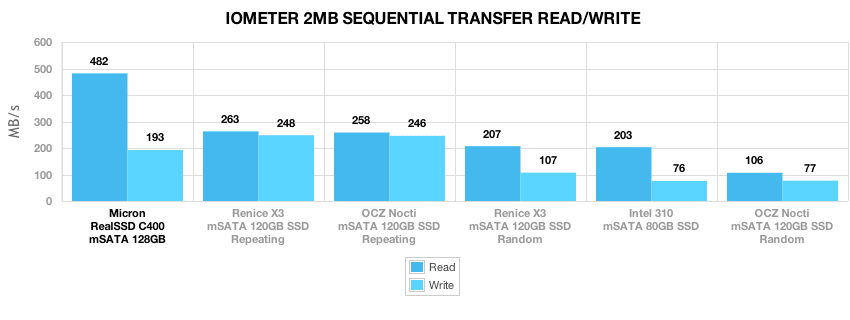
In a sequential transfer test, we measured an average speed of 482MB/s read and 193MB/s write. Read speeds came in sightly lower than the spec, but write speeds more than made up for it.
Our next test measured large-block random transfer performance.
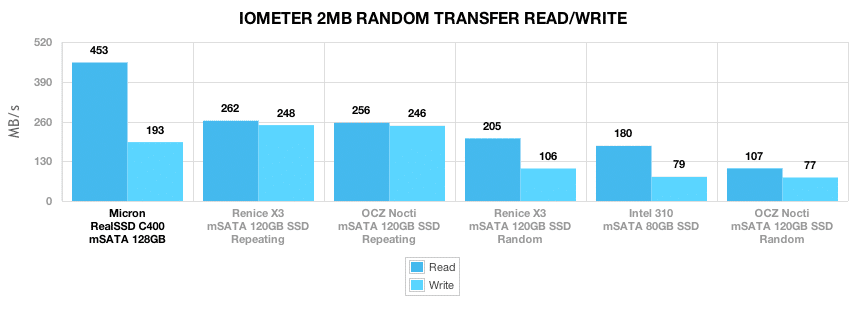
In a random-large block setting the C400 mSATA measured 453MB/s read and kept the same 193MB/s write as in the previous test.
Keeping with the random transfers, we next switch to small-block random 4K at a queue depth of 1.
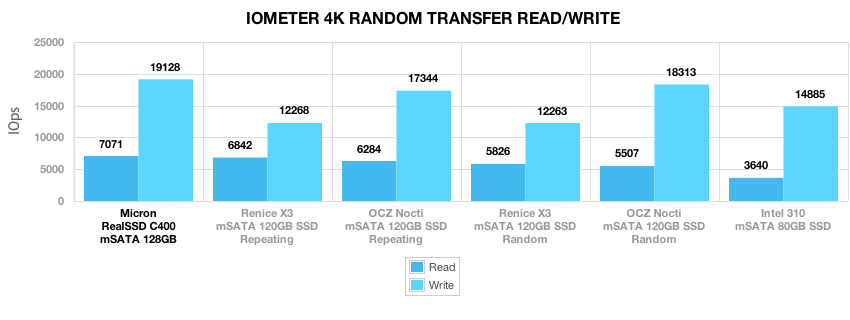
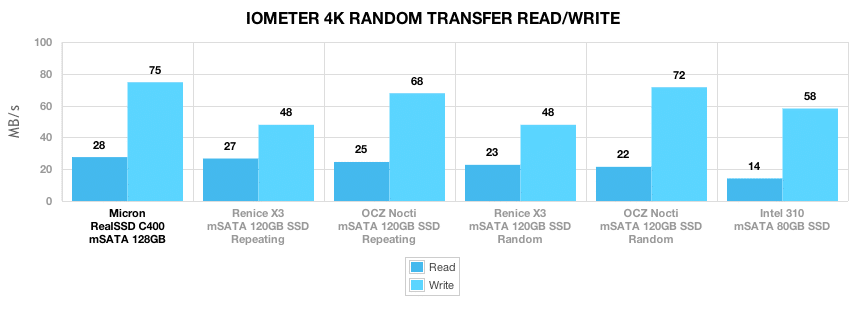
The Micron RealSSD C400 mSATA offered the strongest low queue-depth performance out of the bump, measuring 7,071 IOPS read and 19,128 IOPS write.
Expanding on our QD1 4K test, we look at write latency of each SSD. Lower numbers are better, since it means less wait time for activity to process. Max latency is also important, although that number can change as the NAND wears over time. We measured an average latency of 0.0518ms and a super-low peak latency of 1.45ms from the Micron RealSSD C400 mSATA.
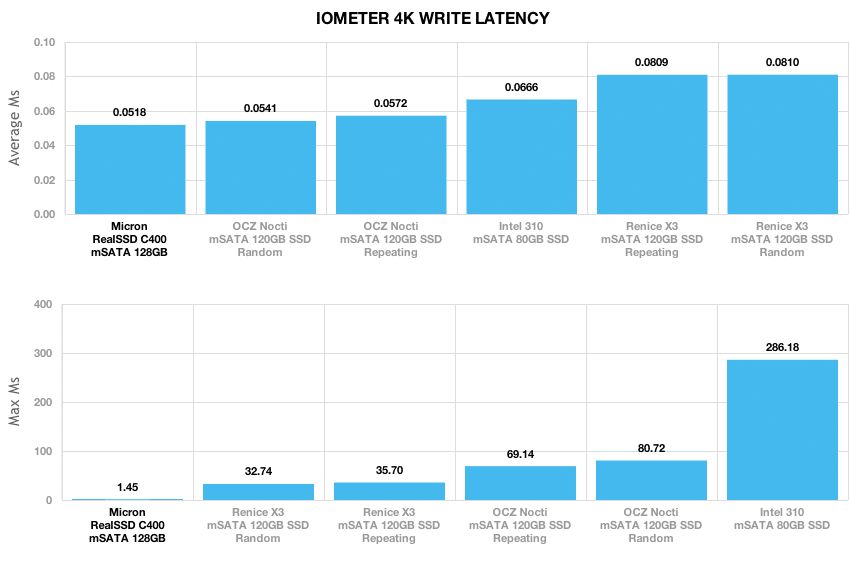
Our last group of consumer IOMeter synthetic benchmarks looks at mixed-load server profiles including Database, Workstation, File Server, and Webserver. In all areas except the read-only Webserver profile, the Micron C400 mSATA came in towards the bottom of the pack of mSATA SSDs.
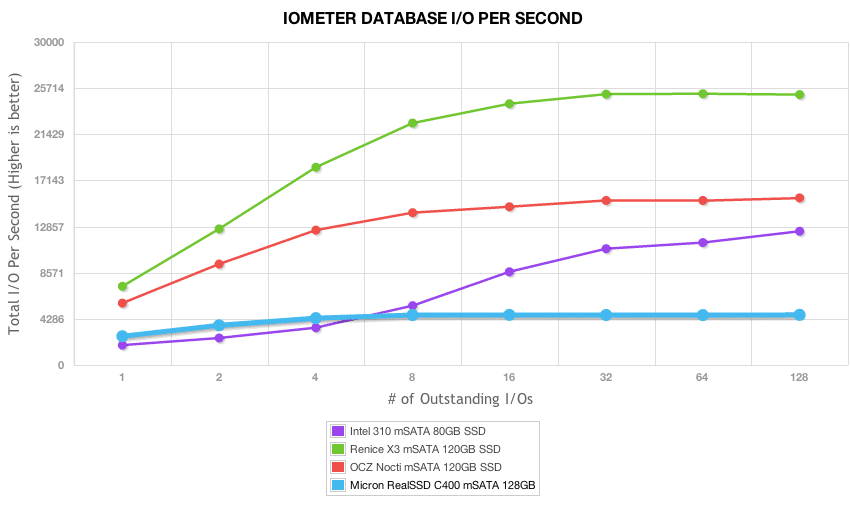
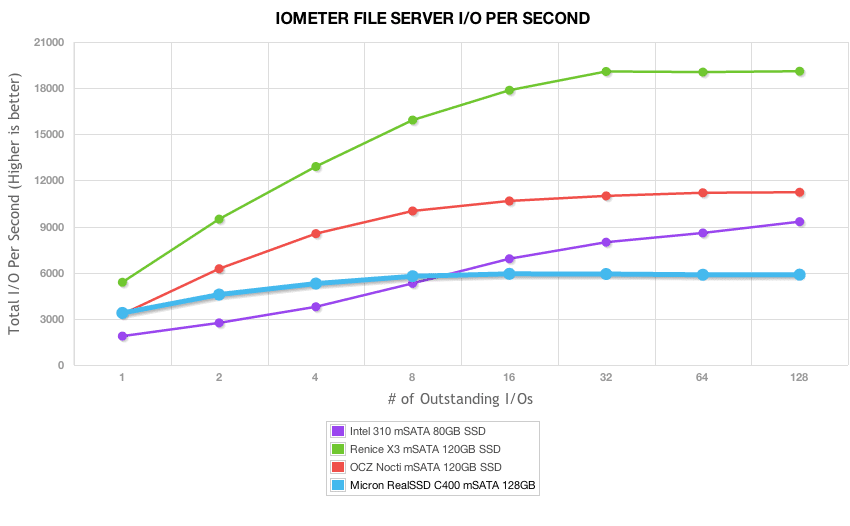
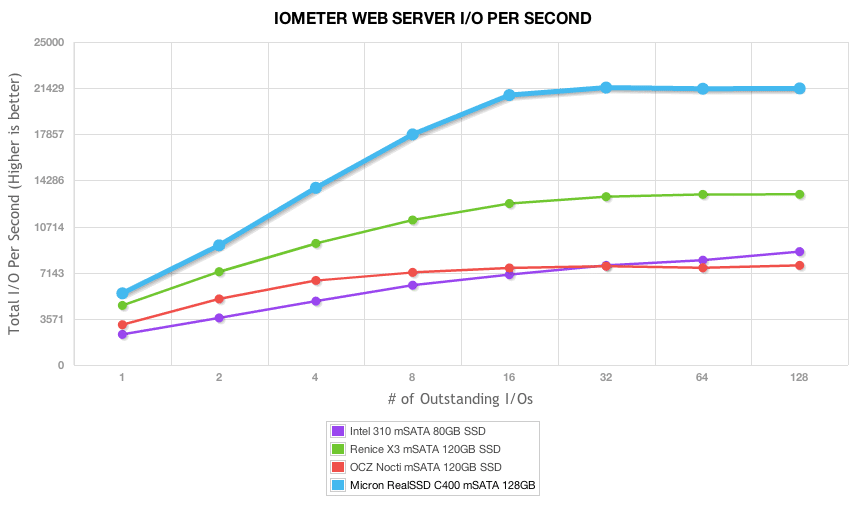
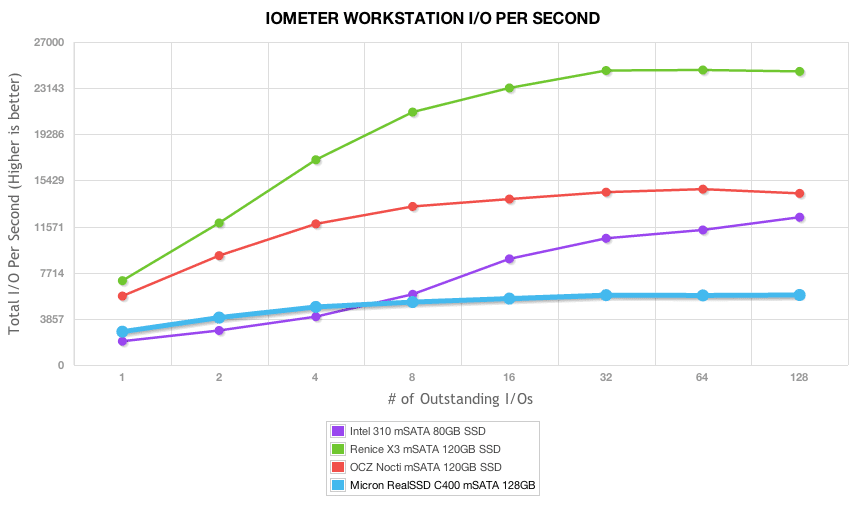
Real-World Benchmarks
For the average consumer, trying to translate random 4K write speeds into an everyday situation is pretty difficult. It helps when comparing drives in every setting possible, but it doesn’t exactly work out into faster everyday usage or better game loading times. For this reason we turned to our StorageMark 2010 traces, which include HTPC, Productivity, and Gaming traces to help readers find out how a drive might rank under their conditions.
The first real-life test is our HTPC scenario. In this test we include: playing one 720P HD movie in Media Player Classic, one 480P SD movie playing in VLC, three movies downloading simultaneously through iTunes, and one 1080i HDTV stream being recorded through Windows Media Center over a 15 minute period. Higher IOps and MB/s rates with lower latency times are preferred. In this trace we recorded 2,986MB being written to the drive and 1,924MB being read. Our second real-life test covers disk activity in a productivity scenario. For all intents and purposes this test shows drive performance under normal daily activity for most users. This test includes: a three hour period operating in an office productivity environment with 32-bit Vista running Outlook 2007 connected to an Exchange server, web browsing using Chrome and IE8, editing files within Office 2007, viewing PDFs in Adobe Reader, and an hour of local music playback with two hours of additional online music via Pandora. In this trace we recorded 4,830MB being written to the drive and 2,758MB being read.
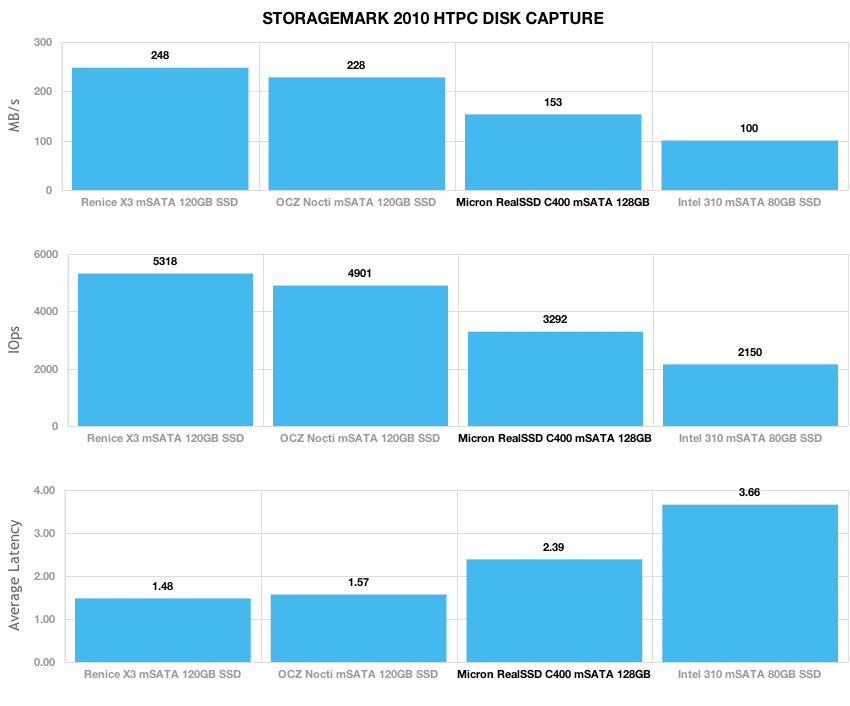
In our HTPC trace the Micron RealSSD C400 mSATA measured 153MB/s average, coming in ahead of the SATA 3Gb/s Intel SSD 310.
Our second real-life test covers disk activity in a productivity scenario. For all intents and purposes this test shows drive performance under normal daily activity for most users. This test includes: a three hour period operating in an office productivity environment with 32-bit Vista running Outlook 2007 connected to an Exchange server, web browsing using Chrome and IE8, editing files within Office 2007, viewing PDFs in Adobe Reader, and an hour of local music playback with two hours of additional online music via Pandora. In this trace we recorded 4,830MB being written to the drive and 2,758MB being read.
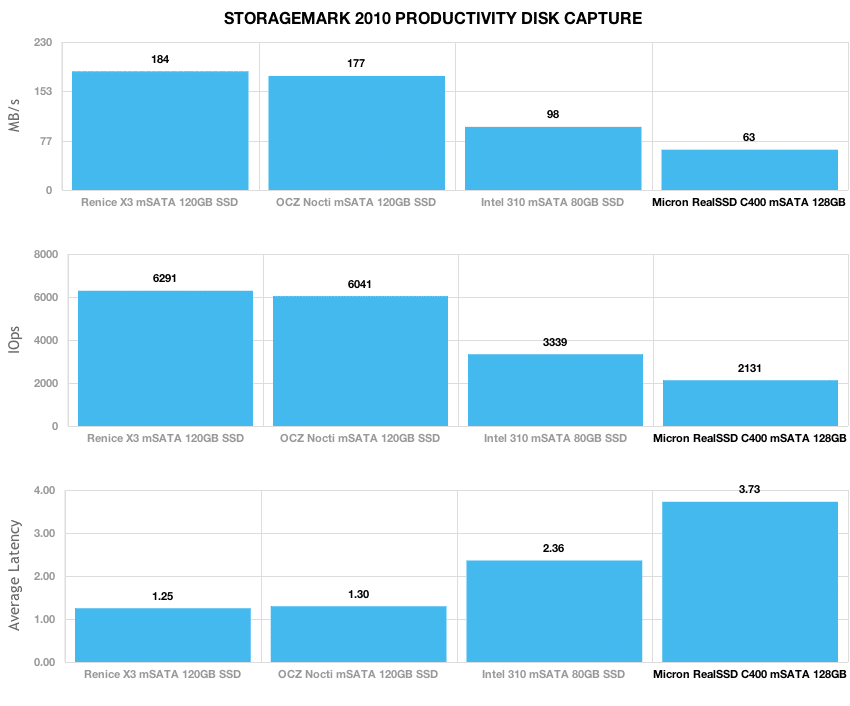
In our Productivity trace, we measured an average speed of 63MB/s, which came in towards the bottom of the pack of mSATA SSDs.
Our third real-life test covers disk activity in a gaming environment. Unlike the HTPC or Productivity trace, this one relies heavily on the read performance of a drive. To give a simple breakdown of read/write percentages, the HTPC test is 64% write, 36% read, the Productivity test is 59% write and 41% read, while the gaming trace is 6% write and 94% read. The test consists of a Windows 7 Ultimate 64-bit system pre-configured with Steam, with Grand Theft Auto 4, Left 4 Dead 2, and Mass Effect 2 already downloaded and installed. The trace captures the heavy read activity of each game loading from the start, as well as textures as the game progresses. In this trace we recorded 426MB being written to the drive and 7,235MB being read.
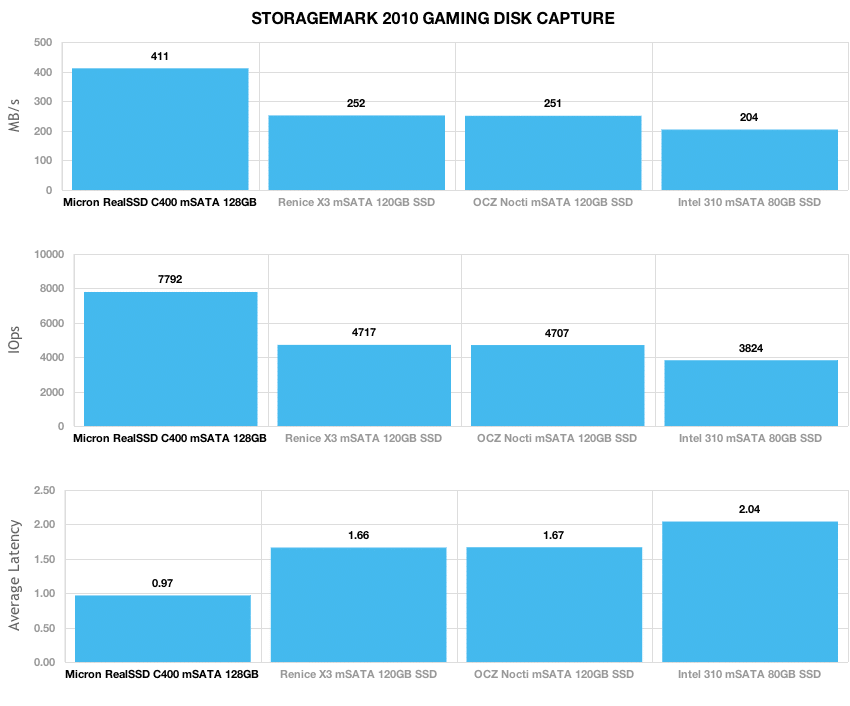
In our read-intensive Gaming trace, the Micron RealSSD C400 mSATA was able to stretch its legs (and SATA 6Gb/s interface) with an average speed of 411MB/s.
Power Consumption
When looking at any modern SSD, power consumption is a huge deciding factor for many mobile shoppers, since the drive itself can make up a large portion of the total power used in a given notebook. In our power consumption tests we look at how much a given drive draws during read and write activities, as well as startup requirements and idle.

Micron lists an average active power consumption of less than 0.2 watts and an idle power value of 0.085 watts for the RealSSD C400 mSATA. In our lab we measured an average idle usage of 1.43 watts, with write activity using 4.41 watts, sequential read using 3.43 watts, random read needing 1.74 watts, and startup consuming 2.26 watts.
Conclusion
The Micron RealSSD C400 mSATA SSD gives OEMs a quality name with longstanding heritage in the NAND storage business a solid option in the ultrathin computing space. With the expected explosion of the Ultrabook space, the smaller C400 mSATAs offers a caching option, while the higher capacity models are ready to perform as the primary storage option in ultrathin notebooks or tablets.
In testing we saw read speeds that benefited from its SATA 6Gb/s interface, although to take advantage of those speeds you need a system with a SATA 6Gb/s mSATA slot. Outside of peak sequential read speeds, performance wasn’t as great as the full-size 2.5-inch C400/m4, with a space constrained NAND-channel design. This is a downside to many mSATA solutions though, since you can only fit so much memory on the small PCB, compared to larger SSDs that can support far more NAND pieces. In mixed workloads, we found the C400 mSATA to fall behind in areas with write activity mixed in, although that behavior is also found on the 2.5-inch C400/m4.
Overall for users looking for another option in the mSATA SSD space, the Micron RealSSD C400 gives users a higher-speed SATA 6Gb/s solution that offers very good read speeds.
Pros
- SATA 6Gb/s ready
- Strong performance in our gaming trace
- Wide capacity offerings to fit budget or task
- Group-leading read performance
Cons
- Falls behind in mixed workloads
- Slower performance in our HTPC and Productivity traces
Bottom Line
The Micron RealSSD C400 mSATA SSD gives OEMs many options for ultrathin computers, tablets and even standard notebooks with models ranging from 32GB to 256GB. Micron has hit the mark with the RealSSD C400 mSATA, selling a model for most use-cases, be it caching solutions or fast primary storage on a SATA 6Gb/s capable Ultrabook.




 Amazon
Amazon